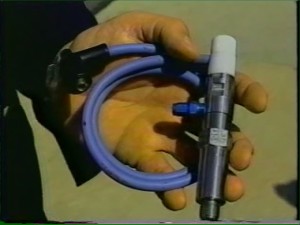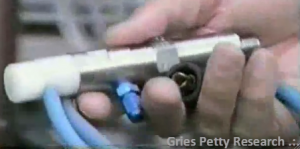Thank you for visiting my website, take a look around and if you have any questions, please email mrgreenenergy@yahoo.com
Contributions to our project are greatly appreciated at this time, we are trying to fund a documentary film and prototyping services.
We intend to bring to market a conversion kit for gasoline vehicles and power generators that allow use of Water as fuel. Through atmospheric water generation we can supply fuel to anyone, anywhere on the planet emission free. Our spark plugs preform electrolysis on water creating Hydrogen and Oxygen, the Hydrogen is combined with Nitrogen extracted from the atmosphere for free clean sustainable gaseous NH3 fuel on demand. latest video link https://www.youtube.com/watch?v=BCSoPfiUkAg
“Q: What is ammonia?A: Ammonia is simply Hydrogen and Nitrogen (NH3). Notice there is no carbon (C) in “NH3”. That means when you burn ammonia, it cannot release carbon dioxide, carbon monoxide, or other greenhouse pollutants.Q: Why use ammonia for a vehicle fuel?A: Ammonia is one of the few practical liquid high-energy density non-petroleum fuels that we will ever have. The laws of physics and chemistry limit the ways in which we can transfer energy efficiently. Ammonia is one of the few chemical compounds which is a liquid, rapidly releases energy in combustion and has a high energy density by volume. All of these parameters are needed for powering vehicles in a practical manner. And as wonderful added bonus, ammonia generates no greenhouse gases or carbon particulate emissions.” nh3car.com
This flame is made of pure water
http://sploid.gizmodo.com/this-flame-is-made-of-pure-water-1453720981
When people hear the news that water or rather the two flammable fuels that make up water can power a car, they often ponder if we have enough water to fuel our society. This is a fair question to ask, however, the planet in covered in water and we already use millions of gallons of fresh water to cool coal fired and nuclear power plants. Each facility consumes over a million of gallons of water each daily, not to mention how much water is used in refining oil or Tar Sand projects. If we used the atomic energy within water we would actually decrease water consumption for power generation by 99%. The fueling station of the NOW is a atmospheric water generator capable of 8 gallons per day from the thin air, this access to pure water can power your home, car and more importantly your families health and vitality.
Researchers at the National Energy Technology Laboratory (NETL) recently demonstrated the latest version of their laser spark plug designed for use with lean burn gas (natural gas and hythane, an 80% CNG, 20% hydrogen mixture) reciprocating engines.
http://www.greencarcongress.com/2008/01/netl-researcher.htmlOriginally designed to study oxy-fuel combustion of natural gas, the Natural Gas Combustion Apparatus has been modified to study non-premixed combustion of a variety of fuels, using air or oxygen as an oxidizer. It is currently being used to study the structure, stability, and emissions of nitrogen-diluted hydrogen diffusion flames. The results may improve the understanding of hydrogen gas turbine combustion in the proposed FutureGen project.
http://netldev.netl.doe.gov/research/on-site-research/research-capabilities/fundamental-combustion-labLaser ignition of bio gasses is already being done in stationary power generators. HHO fuel from water can be ignited the same way. ” A series of tests were conducted by Argonne comparing the performance of conventional CDI ignition and laser ignition in a static chamber and a Rapid Compression Machine. Such tests have shown that sparking becomes easier at higher pressures in the case of laser ignition. Also, laser ignition is found to be capable of extending the lean-ignition limit all the way to the lean-combustion limit (flammability limit). Alternately, laser ignition allowed use of higher rates of charge dilution with exhaust gases or inert gases. ”
http://www.es.anl.gov/energy_systems/research/distributed_energy/ALIS.htmlMIT- “With a single gallon of water, Nocera says, the chip could produce enough electricity to power a house in a developing country for an entire day. Provide every house on the planet with an artificial leaf and we could satisfy our 14 terrawatt need with just one gallon of water a day.
http://tinyurl.com/4f6tkzx “The device is an advanced solar cell, no bigger than a typical playing card, which is left floating in a pool of water. Then, much like a natural leaf, it uses sunlight to split the water into its two core components, oxygen and hydrogen, which are stored in a fuel cell to be used when producing electricity.” NASA ” Excess water vapor is removed by an internal circulating hydrogen system. Hydrogen and water vapor from the reaction exits the cell stack, is mixed with replenishing hydrogen from the storage and distribution system, and enters a condenser, where waste heat from the hydrogen and water vapor is transferred to the fuel cell coolant system. The resultant temperature decrease condenses some of the water vapor to water droplets. A centrifugal water separator extracts the liquid water and pressure-feeds it to potable tanks in the lower deck of the pressurized crew cabin. Water from the potable water storage tanks can be used for crew consumption and cooling the Freon-21 coolant loops. The remaining circulating hydrogen is directed back to the fuel cell stack.
Did you know the atmosphere is roughly 80% Nitrogen and roughly 20% Oxygen? Did you know WATER when turned into its gaseous state, HHO can be combined with ambient Nitrogen for sustainable fueling ?
“By providing energy from a battery, water (H2O) can be dissociated into the diatomic molecules of hydrogen (H2) and oxygen (O2). This process is a good example of the the application of the four thermodynamic potentials.The electrolysis of one mole of water produces a mole of hydrogen gas and a half-mole of oxygen gas in their normal diatomic forms. A detailed analysis of the process makes use of the thermodyamic potentials and the first law of thermodynamics. This process is presumed to be at 298K and one atmosphere pressure, and the relevant values are taken from a table of thermodynamic properties.” —Quantity
H2O
H2
0.5 O2
Change
Enthalpy
-285.83 kJ
0
0
ΔH = 285.83 kJ
Entropy
69.91 J/K
130.68 J/K
0.5 x 205.14 J/K
TΔS = 48.7 kJ—
The process must provide the energy for the dissociation plus the energy to expand the produced gases. Both of those are included in the change in enthalpy included in the table above. At temperature 298K and one atmosphere pressure, the system work isW = PΔV = (101.3 x 103 Pa)(1.5 moles)(22.4 x 10-3 m3/mol)(298K/273K) = 3715 J
Since the enthalpy H= U+PV, the change in internal energy U is thenΔU = ΔH – PΔV = 285.83 kJ – 3.72 kJ = 282.1 kJ
This change in internal energy must be accompanied by the expansion of the gases produced, so the change in enthalpy represents the necessary energy to accomplish the electrolysis. However, it is not necessary to put in this whole amount in the form of electrical energy. Since the entropy increases in the process of dissociation, the amount TΔS can be provided from the environment at temperature T. The amount which must be supplied by the battery is actually the change in the Gibbs free energy:ΔG = ΔH – TΔS = 285.83 kJ – 48.7 kJ = 237.1 kJ
Since the electrolysis process results in an increase in entropy, the environment “helps” the process by contributing the amount TΔS. The utility of the Gibbs free energy is that it tells you what amount of energy in other forms must be supplied to get the process to proceed.”Within the spark plugs chambers water is first heated then turned into fog before being hit with pulsed electrical resonance. 2000- 40000 volts Dc current depending on throttle demand. This type of electrolysis is then combined with a gas processing circuit that extracts Nitrogen from ionized air intake. That gas is combined with the HHO fuel mixture made from water and combined in the 3rd chamber for electron extraction before ignition by timed laser.



Leave a Reply
You must be logged in to post a comment.